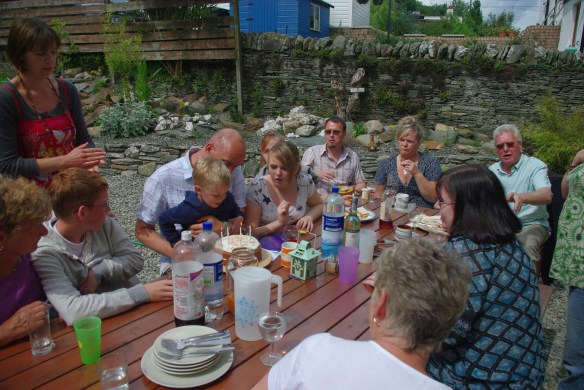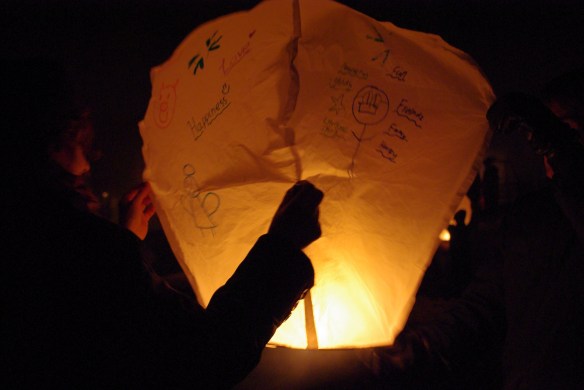The Christian group that I am part of, Aoradh, is now about 7 years old.
We are due to speak at Greenbelt Festival this year about our experience in a session entitled ‘Don’t do it like us; making community in uncool places’. Despite the faux-humble tone of our title, it still feels very bombastic to be speaking about Aoradh in such declarative fashion.
Planning what we will say does start to focus the mind on what we hold precious however, and also brings to light those rather tender areas of our small group where there are wounds and vulnerabilities. We have had a little reminder of this recently- issues that flare and fester for a while, which can be very painful. They can also be the end of small groups based essentially on friendship and shared passion; there have been several points over the years at which Aoradh could have ended.
Despite the pain of this, I have come to see these tensions as above all- normal, inevitable.
The deep friendships that we value so highly within our community will always mean a suspension of defences, and perhaps a tendency to reveal some of our less attractive personality traits which pop out under pressure.
Then there are all the group processes that you have to work out; leadership, facilitation, communication, agreeing principles, organising your business, looking after those who are on the edge. I confess to avoiding some of the theory of how all of this works- there is of course a whole industry looking at group dynamics. The idiosyncrat in me wants to flee from the regimented check list nature of this kind of thing.
But we can always learn from the experience of others- that is why we are doing the Greenbelt talk/discussion session after all.
A few years ago I read a couple of M Scott Peck’s books, including the surprisingly wonderful ‘A different Drum; community making and peace’. Surprisingly because I read it reluctantly- I had pegged it as new-age-psychobabble-pop psychology-nonsense. What Peck does though is to give a passionate analysis of the group as the highest form of what we humans are. He describes community building like this;
- Pseudocommunity: In the first stage, well-intentioned people try to demonstrate their ability to be friendly and sociable, but they do not really delve beneath the surface of each other’s ideas or emotions. They use obvious generalities and mutually-established stereotypes in speech. Instead of conflict resolution, pseudocommunity involves conflict avoidance, which maintains the appearance or facade of true community. It also serves only to maintain positive emotions, instead of creating safe space for honesty and love through bad emotions as well. While they still remain in this phase, members will never really obtain evolution or change, as individuals or as a bunch.
- Chaos: The first step towards real positivity is, paradoxically, a period of negativity. Once the mutually-sustained facade is shed, negative emotions flood through: Members start to vent their mutual frustrations, annoyances, and differences. It is a chaotic stage but Peck describes it as a “beautiful chaos” because it is a sign of healthy growth. I would add that many groups do not survive this stage, and at least, many people will leave.
- Emptiness: In order to transcend the stage of “Chaos”, people are forced to communicate. Things that get in the way of communication are forced aside, or at least forced out into the open- need for power and control, self-superiority, and other similar motives which are only mechanisms of self-validation and/or ego-protection, must yield to empathy, openness to vulnerability, attention, and trust. Hence this stage does not mean people should be “empty” of thoughts, desires, ideas or opinions. Rather, it refers to emptiness of all mental and emotional distortions which reduce one’s ability to really share, listen to, and build on those thoughts, ideas, etc. It is often the hardest step in the four-level process, as it necessitates the release of patterns which people develop over time in a subconscious attempt to maintain self-worth and positive emotion. For Peck, it should be viewed not merely as a “death” but as a rebirth — of one’s true self at the individual level, and at the social level of the genuine and true Community.
- True community: Having worked through emptiness, the people in the community enter a place of complete empathy with one another. There is a great level of tacit understanding. People are able to relate to each other’s feelings. Discussions, even when heated, never get sour, and motives are not questioned. A deeper and more sustainable level of happiness obtains between the members, which does not have to be forced. Even and perhaps especially when conflicts arise, it is understood that they are part of positive change.
Any of you who are frustrated in organised church (as I have been) will recognise immediately the fact that most churches are pseudocommunities. All that politeness and veneer of respectability. Any conflict is immediately suppressed by the paid leaders, and it is possible to be entirely anonymous and disengaged in these places. To be fair there are many that like it this way, but to me it was a kind of death.
Has Aoradh achieved Pecks kind of true community? Sometimes I would say yes, other times emphatically no. Because I am not sure that the formation of community is actually a LINEAR process like this. Circumstances change, different people join the group then leave. Rather community is something that ebbs and flows, sometimes becoming constrictive and even boring, at other times full of creative energy and passion.
Peck also wrote of list of what he saw as characteristics of true community. These I like more, as they are less mechanistic and more inspirational;
- Inclusivity, commitment and consensus: Members accept and embrace each other, celebrating their individuality and transcending their differences. They commit themselves to the effort and the people involved. They make decisions and reconcile their differences through consensus.
- Realism: Members bring together multiple perspectives to better understand the whole context of the situation. Decisions are more well-rounded and humble, rather than one-sided and arrogant.
- Contemplation: Members examine themselves. They are individually and collectively self-aware of the world outside themselves, the world inside themselves, and the relationship between the two.
- A safe place: Members allow others to share their vulnerability, heal themselves, and express who they truly are.
- A laboratory for personal disarmament: Members experientially discover the rules for peacemaking and embrace its virtues. They feel and express compassion and respect for each other as fellow human beings.
- A group that can fight gracefully: Members resolve conflicts with wisdom and grace. They listen and understand, respect each others’ gifts, accept each others’ limitations, celebrate their differences, bind each others’ wounds, and commit to a struggle together rather than against each other.
- A group of all leaders: Members harness the “flow of leadership” to make decisions and set a course of action. It is the spirit of community itself that leads and not any single individual.
- A spirit: The true spirit of community is the spirit of peace, love, wisdom and power. Members may view the source of this spirit as an outgrowth of the collective self or as the manifestation of a Higher Will.
Is this Aoradh? My heart says YES.
My experience says it is the best of what we are, but it is not all that we are.
However, this too is normal. If we are moving towards the light through many dappled shades of darkness, then why would we not expect the same from ourselves in the collective? What Peck remind me of however, is that our groups have the capacity not to be just the sum of the parts within them– they are far more than just a gathering of individuals in one place. Rather they are the place of becoming.
They are not places where conflict is tolerated and excused as somehow ‘developmental’, rather places where conflict is understood and wounds are healed. It is a major distinction.
The writer of the Psalm 133 understood this.
1 How good and pleasant it is
when God’s people live together in unity!



I would never accuse you of being bombastic: I am sure what you all say will be open and honest and will help people. This post is good!
Where is the Greenbelt Festival?
Details here Harrison- http://www.greenbelt.org.uk/
I think there is a link to your ‘Wild goose festival’?
Cheers
Chris
Thanks! All the best!
Came across this through Jonny Baker’s blog – v helpful, thanks for sharing.
Cheers Andrew
Thank you for your reflections, I found that really uplifting this morning. We are part of small group in Bath called Sanctuary, so much of what you described has been our experience. Great to be reminded again it’s not just us!, we have been going for 13 years, not quite sure how we are still around really, but the one thing I think has kept us going is a deep love and caring for one another. I look forward to hearing you at greenbelt
Cheers Sonia- I have heard of Sanctuary- through Tautoko I think? Your contributions @ GB will be very welcome!
Chris
Pingback: Leaving Church 1- discussion with Jason Clark… | this fragile tent
Pingback: Leadership in small missional groups, reviewed… | this fragile tent
Pingback: Remaking religion; power and community… | this fragile tent